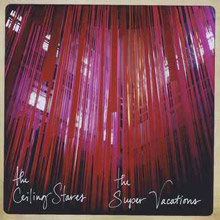by Kevin J. Elliott
The concept of the split-single has always been a dicey proposition for bands looking to share their sound in an economical format. Now, given the instantaneous promotion the internet provides, it seems even more maniacal for two groups to join forces just for three minutes of glory. For the consumer, you usually pick a favorite and therefore ignore the other side for as long as you play the damned thing. For the bands, they’ll forever be associated with whomever they shared the vinyl—whether they like it or not. To be honest, split-singles don’t really exist in the racks much anymore, and I can’t tell you the last time I’ve actually sat down and enjoyed one front to back. So this month, I scoured the pile for splits and came up with two records which illustrate the dos and don’ts of this long neglected tradition.

Harbor Lights, “The Price Is Right” b/w Ribs, “A Red 1” (Power)
This is a great example of a split-single done the right way. Long before Power Records took shape, the musicians behind this split—Jason Frederick, Brad Swiniarski, and Joachim Kerns—ruled the roost during Columbus, Ohio’s early millennial slump. Kearns and Swiniarski were integral parts of Bob City, while the latter and Frederick made up half of The Means. Both were bands who helped define a particularly gnarly post-grunge, post-pigfuck sound in a pre-hipster era. Back then trucker hats and PBR were still considered trailer park novelties. It nice to see that years removed from that scene, the trio is alive and well and stilll making music together, albeit from distant locales; while Swiniarski has remained in Columbus, Kerns lives in Brooklyn and Frederick calls Chicago home.
The one constant here is Kerns, who plays guitar on both sides and is one of the guys running the label. His choogling rhythms and complex playing bodes for a welcomed introduction on the two songs here. Harbor Lights’ “The Price Is Right” steers close to power-pop, but you can tell these were guys who survived Nirvana and adopted those heavy riffs without really paying much attention. Instead, I can only assume they were into Superchunk (if only for their velocity), Seaweed, and more obscure bands like Love Battery, as the song has a definite off-the-grid feel. Their true love is probably Thin Lizzy, because the backbone of “The Price Is Right” revels in the crossfire of that band’s twin guitar solos. Righteous stuff indeed, and I’m looking forward to what Harbor Lights can do on a full-length.
The big shift comes with Frederick’s Ribs. Anyone who has ever heard The Means—or any other project that included Frederick—will sense that the man has cooled off and chilled out with increased age. There’s no growling or rants on “A Red 1.” It’s a more sophisticated swagger with a gritty underbelly still lurking. Shuffling in, the song resembles that time in New York when this kind of dirty pop was just starting to form. I’ve long held the theory that there would be no Strokes were it not for Jonathan Fire*Eater, and with “A Red 1,” Frederick shares that notion. Though it sounds like a time machine, I’m fully inclined to take the ride with Ribs.

The Ceiling Stares, “A Tunnel Through the Air” b/w The Super Vacations, “Hexing” and “Controller” (Sweaters and Pearls)
Here’s an example of how not to assemble a split-single. When eying the cover, my kneejerk reaction was to never play the thing and immediately file it to the back of the pile. There were twee signifiers all over the thing: quaint band names written in cursive, a nondescript photo of streamers at a children’s museum, and a cutesy record label. The red flags hinted at what it sounded like before even putting it on. Though The Ceiling Stares take the twee cake here, it’s arguably the best part of this single. From the outset, keyboards twinkle in a grand hall, and the band begins singing in an Arcade Fire–like choral chant while drums pitter-patter in the soft-fi mix. It was almost time to cut them short, when all of a sudden they transformed “A Tunnel Through the Air” into a blustery and almost raw sort of march. The guitars got heavier, the vocals became an anthem, and the things that made them too cute began to evaporate. Yes, Springsteen-isms abound here as well, but I found myself singing along, hoping the flip would provide the same surprise over my initial expectations.
Unfortunately, that was not the case, and now The Ceiling Stares will forever be associated with the lesser Super Vacations. As for their two songs, “Hexing” and “Controller,” I have no idea where their inspiration comes from. At first their sound shimmers in the dark like early Cure or the more romantic shoegazers squeezed through the motions of one of those young, enterprising neu psych-garage bands. Think Interpol donning paisley to become something akin to Woven Bones—ugh. You can tell the band are studied but don’t know what to do with that talent. Instead, they glaze over their worth with generic riffs and even more embarrassing songwriting. It almost seems they are playing badly on purpose to maximize the hazy effect. Though “Controller” is the better of the two songs here, this side is completely forgettable, if only because there are numerous bands these days doing the same thing with much more palatable results.
PRIMITIVE FUTURES
Introducing... Gross Magic
Jerusalem and the Starbaskets, DOST
Sic Alps, Breadhead and "Battery Townsley"
King Dude, Tonight's Special Death
September Singles Round-Up
Introducing... Acid Baby Jesus
Bruit Direct Disques' Summer Soiree
Wavepool Abortion
Factorymen, Shitman and Yellow Eyes and the Sound of Vomit EP
Liquor Store, Yeah Buddy
Bonus Summer Singles Round-Up
Introducing... Rimar
August Singles Round-Up
Imaginary Softwoods, The Path of Spectrolite
